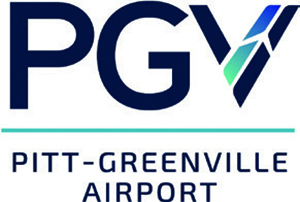Pitt-Greenville Uses Pandemic Stimulus Funds for New Hangars

When one door shuts, there’s always an open window nearby. And COVID slammed a lot of doors. When commercial traffic at Pitt-Greenville Airport (PGV) took a severe dip during the global COVID-19 pandemic, the North Carolina airport did more than open a window. It built its own doors…on five new hangars for corporate aircraft.
The construction project was the Pitt-Greenville Airport Authority’s way of generating a new source of revenue in the fast-changing pandemic-ravaged landscape. Certificates of occupancy were received in March, and all five hangars are already open for business.

Four are 13,200 square feet, spacious enough to hold a Gulfstream G650. The fifth hangar is 6,400 square feet, with enough room for a Bombardier Challenger 300. The hangars have hydraulic lift doors and offer direct access to PGV’s corporate taxi lane. The four larger hangars feature space for an office or pilot lounge partitioned by fire-rated walls.
The $9.8 million dollar project is among the first of its kind in the U.S. to be funded through the CARES (Coronavirus Aid, Relief, and Economic Security) Act, a federal pandemic stimulus package launched in 2020. “I’m very excited that we’ve had this opportunity to build these hangars and basically not take on any debt and own them outright,” says Bill Hopper, executive director of the Pitt-Greenville Airport Authority.
|
Project: New Corporate Hangars Location: Pitt-Greenville Airport—Greenville, NC Scope: 5 hangars Hangar Sizes: 4 with 13,200 sq. ft. of space; 1 with 6,400 sq. ft. of space Approx. Cost: $9.8 million ($9.1 construction; $336,000 design; $336,000 construction management & administration) Funding: Nearly $9.8 million from CARES Act; $9,000 from Airport Authority Construction: July 2022 - March 2023 Civil Engineers: Talbert & Bright Contractor: Farrior & Sons Structural Engineers: RPA Engineering
Plumbing, Electrical & Mechanical Engineers:
Architect: Hangar Doors: Southeast PowerLift Hydraulic Doors Inc. Key Benefits: Add new revenue stream; offset pandemic-induced losses; support local economic development |
Shoring Up Revenue
In 2020, PGV saw fewer than half the passengers it did in 2019. A few months into the pandemic, the airport’s only commercial carrier, American Airlines, temporarily suspended all flights to PGV, as well as 14 other U.S. regional airports. Like its industry counterparts, PGV is still recovering from those losses.
“We took a very big hit on the air service side like a lot of small regional airports,” says Hopper, noting 60% reduction in air service since before the pandemic. Because Pitt-Greenville Airport Authority owns the airfield’s fixed-based operator, it also felt the direct hit of decreased fuel sales to airlines. Moreover, airport parking lots that were traditionally full regularly had plenty of available spaces—a noticeable shift from the years before COVID-19.
When CARES funding became available, Hopper jumped on the opportunity to diversify PGV’s revenue stream. If all goes as expected, the new hangars will provide additional lease revenue and also increase fuel sales. “It’s not going to completely make up for the air service that we had reduced, but it helps quite a bit in trying to catch up,” Hopper says. “Hopefully, we will get the air service back. And when we do, it will be an additional revenue source where maybe we can start putting money aside for other things [like other construction or repairs].”
The Funding Process
Prior to receiving CARES Act funding, the Airport Authority was already working on a long-term plan to grow its hangar capacity. Prior to the pandemic, it had been saving for new hangars and had already built a corporate taxi lane using Airport Improvement Program funding. The plan was to build one hangar at a time as funds became available. But the project shifted into high gear when PGV received a CARES grant through the FAA.
“The FAA set aside a very specific amount towards development, and we saw that we could use that to build hangars,” Hopper says. “The board was very much committed to it because they saw it as an opportunity to use that federal money so we could have a revenue-generator.”

In total, the project cost $9,808,462, and fully $9,799,463 was paid for with CARES Act funding.
“It was an exciting project because grant money is rarely available to air carrier airports to build hangars,” says Jay Talbert of Talbert & Bright, the civil engineering firm behind the project. “And they’re currently working on a project that will add two more good-sized corporate hangers in addition to these five that were recently completed.”
Construction on the two additional hangars is expected to commence this fall, with projected completion in fall 2024.

Supply Chain Hurdles
 The project broke ground in July 2022, and construction coincided with a series of now-infamous supply chain hiccups that throttled production worldwide. “One of the challenges with the project was the crazy lead time for steel and electrical components,” notes Eric Stumph of Talbert & Bright. “[That] caused some consternation and some juggling as the project moved.”
The project broke ground in July 2022, and construction coincided with a series of now-infamous supply chain hiccups that throttled production worldwide. “One of the challenges with the project was the crazy lead time for steel and electrical components,” notes Eric Stumph of Talbert & Bright. “[That] caused some consternation and some juggling as the project moved.”
At times, key components would go adrift in supply chain limbo. “We would have the entire building there and all the panels...but not the clips that held everything together,” remembers Talbert. “[The supplier] left those out of the package. They were somewhere on a ship off Los Angeles, sitting out there, and couldn’t get to Greenville. So we lived through all of that on this project, but it ended up being a great project.”

Of course, it’s never easy to venture into new funding territory. “I think we were one of the first through the door to use [CARES Act] money for something like this,” Hopper says. “And so that was a very big learning process for both the FAA and for the airport...There were delays in the reimbursement, but a big part of that is just because of it being a new process.” Eventually, “the FAA worked with us, and then we did start getting reimbursement much more quickly. But it was very much a learning process for the FAA, and for the airport.”
 Through each uncertainty, the team pulled together. “Bill Hopper was absolutely amazing to work with and very accommodating,” says Bill Farrior Jr. of construction contractor Farrior & Sons. “It was also the first time we’ve ever worked with Talbert & Bright, and they were also really easy to work for as well. If a problem arose, everybody kind of worked together as a team to resolve it, versus how it is some other times.”
Through each uncertainty, the team pulled together. “Bill Hopper was absolutely amazing to work with and very accommodating,” says Bill Farrior Jr. of construction contractor Farrior & Sons. “It was also the first time we’ve ever worked with Talbert & Bright, and they were also really easy to work for as well. If a problem arose, everybody kind of worked together as a team to resolve it, versus how it is some other times.”
Community Project
Beyond generating extra revenue for PGV, the new hangars may also stand as a symbol of rejuvenation for an industry that generates more than 1,000 jobs in the Greenville area and brings in millions of dollars to the local economy. In 2019, PGV recorded an output of $280.7 million and provided 1,650 jobs.
Looking forward, each new hangar could potentially yield an additional $100,000 in annual lease revenue for the airport. On top of direct airport revenue, the companies that will ultimately rent the spaces could bring in more jobs and revenue for the community as a whole.
During the project, the Airport Authority made a concerted effort to invest in the region by working largely with eastern North Carolina firms. Dunn & Dalton, the project architect, has been a fixture of the nearby small town of Kinston for nearly 30 years. Farrior & Sons is a fourth-generation North Carolina family business.
The new hangars are located just off North Memorial Drive, one of Greenville’s busiest roads, offering passing drivers a front-row view of what their neighbors have built together. “It’s very visible to the community, where those buildings are located,” says Farrior. “You don’t see that every day around east North Carolina. We were excited to be a part of a large project that is highly visible to the public.”
2022 Charlotte Douglas International Airport Report of Achievement
 Giving back to the community is central to what Charlotte Douglas International Airport and its operator, the City of Charlotte Aviation Department, is about, and last year was no different.
Giving back to the community is central to what Charlotte Douglas International Airport and its operator, the City of Charlotte Aviation Department, is about, and last year was no different.
Throughout 2022, while recovering from the COVID-19 pandemic, we continued our efforts to have a positive impact on the Charlotte community. Of particular note, we spent the year sharing stories of how Connections Don't Just Happen at the Terminal - from creating homeownership and employment opportunities to supporting economic growth through small-business development and offering outreach programs to help residents understand the Airport better.
This whitepaper highlights the construction projects, initiatives, programs and events that validate Charlotte Douglas as a premier airport.
Download the whitepaper: 2022 Charlotte Douglas International Airport Report of Achievement.
 facts&figures
facts&figures








